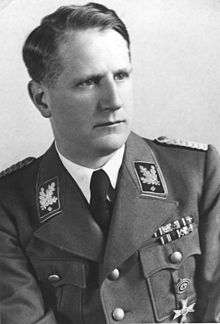Leonardo Conti
| Leonardo Conti | |
|---|---|
 SS-Gruppenführer Dr Conti | |
| Born |
24 August 1900 Lugano, Switzerland |
| Died |
6 October 1945 (aged 45) Nuremberg, Germany |
| Allegiance |
|
| Service/branch |
|
| Rank |
|
Leonardo Conti, MD (24 August 1900 in Lugano – 6 October 1945 in Nuremberg) was the Reich Health Leader (German: Reichsgesundheitsführer) in Nazi Germany. The killing of a large number of Germans who were of "unsound mind" is attributed to his leadership.[1]
Biography
Conti was born to a Swiss Italian father, Silvio, and a German mother, Nanna Pauli, in Lugano, Ticino, Switzerland; his mother later became the Reich Midwifery Leader in Nazi Germany.
Conti later studied medicine in Berlin (Friedrich Humboldt Universität, F.H.U) and Erlangen (Friedrich Alexander Universität, F.A.U). He became active in the völkisch movement, and co-founded an antisemitic paper called Kampfbund ("Struggle league"). He took part in the Kapp Putsch in 1920. From 1923 he was a member of the Sturmabteilung (SA), becoming their first physician; one of his patients was Horst Wessel, who eventually became a martyr of the Nazi Party. In 1925, he promoted "Über Weichteilplastik im Gesicht", a book about facial plastic surgery. In 1927 he left his usual activities and started organizing the National Socialist German Doctors' League (NSDÄB) (German: Nationalsozialistischer Deutscher Ärztebund) in Berlin.
He joined the Schutzstaffel (SS) and, as an "old fighter" of the party, he was appointed by Hermann Göring to the Prussian State Council. Conti held the posts and titles of Head of the Reich Physicians' Chamber (German: Reichsärztekammer), Leader of the NSDÄB, and Leader of the Main Office for the People's Health. In 1937 he was elected to the presidency of the FIMS, the International Federation of Sports Medicine.[2] The FIMS today considers this to have been "a black page' in their history. In 1939, Conti was appointed Reichsgesundheitsführer and State Secretary in the Interior Ministry. On the first of July 1941, as the Chief of Health in the Reich, he obtained the classification of Pervitin (see History and culture of substituted amphetamines) among the products defined by Reich law on opiates. It condemns the private use of Pervitin but does not call into question its use for military purposes.[3] In 1944, he was promoted to SS-Obergruppenführer (English: Lieutenant General).
Action T4
Leonardo Conti was a staunch promoter of a public medical administration strongly controlled by the Nazi state. Under his leadership, local health offices were further expanded to allow for a genetic control and selection of the population in order to remove "weak" elements for the improvement of the German race. Accordingly he was co-responsible for the forced sterilization program, the racially motivated forced pregnancy interruptions, and ultimately the Action T4 program.[4] It is also undisputed Conti's participation in human experiments.[4] The Nazi involuntary euthanasia program involved the planned murder of mentally and physically impaired patients and started on September 1939 when the policy was personally approved by Hitler. The killings were conducted in many hospitals and asylums by a variety of methods, including starvation, injection of lethal drugs, and gassing using carbon monoxide. The program constitued the basis for the later program of mass murder of Jews, Poles, as well as other Slavs, and Russian POWs in camps such as Treblinka, Sobibor, Belzec, Chelmno, Auschwitz-Birkenau, and Majdanek.
At war end
On 19 May 1945, after Germany's surrender, Conti was imprisoned and would have been brought to the Doctors' Trial for his involvement in Action T4. However, on 6 October 1945, over a year before the trial began, he hanged himself.[5]
References
- ↑ Snyder, Louis L. (1976). Encyclopedia of the Third Reich. McGraw-Hill. ISBN 9780709157175.
- ↑ "Our History". International Federation of Sports Medicine (FIMS).
- ↑ La Pilule de Göring. La fabuleuse histoire de la pervitine on YouTube
- 1 2 Leyh, Ernst-Alfred (2002) Leonardo Conti and the "ideologization of medicine during the Nazi dictatorship" (abstract). Universitätsbibliothek Heidelberg (in German).
- ↑ Wistrich, Robert S. (4 July 2013). Who's Who in Nazi Germany. Routledge. pp. 31–2. ISBN 978-1-136-41388-9.
External links
-
 Media related to Leonardo Conti at Wikimedia Commons
Media related to Leonardo Conti at Wikimedia Commons - Biography of Leonardo Conti
- Leonardo Conti in the German National Library catalogue (in German).